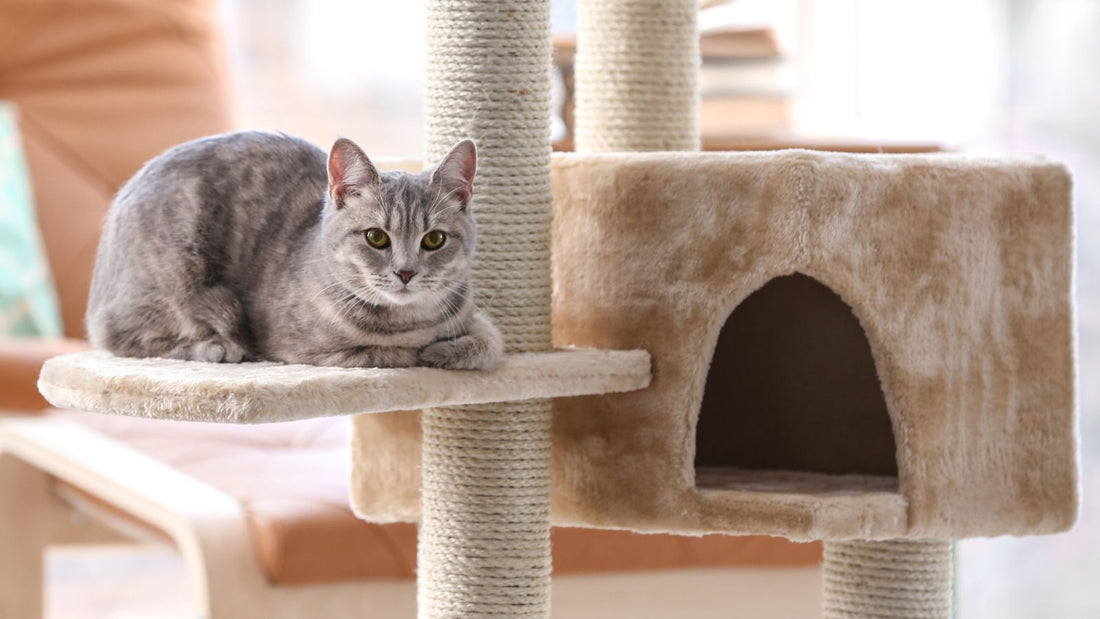
How to clean a cat tree?
A cat tree is more than just an accessory: it's a veritable playground, resting place, and sometimes even a retreat for your feline companion. A scratching post, perch, hiding place, or observation point, it's part of their daily life. But over time, it can quickly become a nest of hair, dust, bacteria , and even unpleasant odors. To ensure your cat's health and extend the life of your cat tree, regular cleaning is essential. Here's how to do it properly.
Why clean a cat tree regularly?
A cat tree is used daily: to sharpen its claws, rub itself, sleep or play. Over time, it accumulates:
- Dead hairs
- Dust
- Scratch residue
- Saliva or secretions
- Urine stains or other small "accidents"
- Unwanted odors
A poorly maintained tree can cause allergies, attract parasites (fleas, mites), or simply become less pleasant for your cat. Furthermore, since cats are very clean animals and sensitive to odors, a dirty tree can cause them to abandon it.
How often should you clean a cat tree?

The ideal frequency depends on the number of cats, their activity, and the general environment (long hair, shedding period, animals that go outside, etc.).
Here is a base to adapt according to your home:
- Quick maintenance: once a week
Vacuuming hair, shaking out cushions, general inspection.
- Complete cleaning: 1 to 2 times per month
Deep cleaning of all surfaces, fabrics, poles, hanging toys, etc.
The necessary equipment

- To effectively clean a cat tree, here is what you will need:
- A vacuum cleaner (ideally with a brush attachment)
- A sticky brush or a hair removal glove
- A clean sponge or microfiber cloth
- Mild soap or a natural cleaner (such as black soap or white vinegar)
- Warm water
- A hard bristle brush (for sisal scratching posts)
- A natural disinfectant spray that is safe for animals (optional)
Avoid products containing ammonia or toxic agents, as these may irritate your cat or prevent them from using the tree again.
Steps to Cleaning a Cat Tree
1. Remove moving parts
Start by removing any cushions, hanging toys, or other removable accessories. If they're machine washable, now's the time to wash them at 30°C with a mild detergent.
2. Vacuum up hair and dust
Use a vacuum cleaner to cover all surfaces: platforms, niches, hammocks, and ledges. Use a brush attachment to thoroughly remove embedded hairs. For hard-to-reach areas, a hair-removing glove or a sticky brush can work wonders.
3. Clean fabric surfaces
Using a slightly damp sponge with warm water and a little mild soap, scrub fabrics, cushions, and niches. You can also use a mixture of white vinegar and water (half and half) to disinfect naturally without leaving a strong odor.
Be careful not to soak the fabrics or wooden boards underneath—moisten just enough and then dry thoroughly.
4. Disinfect sensitive areas
If your cat has had a minor accident or if the odor persists, you can use a natural disinfectant spray (lemon, baking soda, or vinegar). Let it sit for a few minutes, then wipe with a clean cloth.
5. Clean the scratching posts
Sisal posts can be a real breeding ground for dust and debris. Brush them vigorously with a stiff-bristled brush to remove debris stuck in the fibers. You can also wipe them with a damp cloth to refresh the rope.
6. Clean hanging toys
Small toys attached to platforms can get dirty, especially if they're chewed on frequently. Clean them with a damp cloth and mild soap. If they're worn or moldy, don't hesitate to replace them.
7. Dry and air the cat tree
Allow the tree to dry completely before your cat uses it again. You can place it near a window or wipe it down with a dry cloth to speed up the process.
Tip: Baking soda to eliminate odors

If certain areas of the tree give off a bad odor, sprinkle them with baking soda, let it sit for a few hours (or overnight), then vacuum. It's a natural, safe, and incredibly effective deodorizing solution.
Some tips for long-term tree maintenance
- Install it in a dry place to avoid humidity and mold.
- Brush your cat regularly to limit hair loss on fabrics.
- Check screws and fasteners every time you clean them to ensure stability.
- Add a washable cover on the platforms for easy maintenance.
- Monitor the condition of the sisal : if it is too damaged, you can replace it yourself at low cost.
Conclusion
Cleaning a cat tree is a simple but essential task to ensure a healthy, comfortable, and long-lasting environment for your feline companion. By dedicating a few minutes each week, you can prevent unpleasant odors, hair buildup, and health risks, while extending the tree's lifespan. And most importantly, you'll show your cat that their space is clean, respected, and always welcoming!
